Table of Contents
The chemical name for the substance of quartz is silica; and any mineral that is composed in part of silica is a silicate. In the Classification of Silicate Minerals and the study of minerals and rocks, silica is called an acid; in silicates, the substances other than silica are called bases, for example, lime, potash, and soda. When giving the full name of a silicate the names of these bases will generally be used, but the names of the metals of which they are the oxides will be substituted if better known. The silicates are of importance, both as useful materials. and because some of them make up in whole or in part a good many common rocks, such as diabase, granite, syenite, gneiss, etc. All the silicates here described are non-metallic in luster.
Feldspars
Hornblende VS Amphibole
Amphibole & Hornblende form a group of silicates of magnesia, lime, iron, etc., variable in composition, but having a general resemblance in properties. Common hornblende is a silicate of magnesia, iron, and lime, with some soda and alumina. Color, between black and white, inclining to blackish green; powder, gray or white; luster, glassy; H = 5 to 6; G = 2.9 to 3.4; crystals, in monoclinic system; cleavage, perfect, the cleavage surfaces making angles of about 56° and 124°.
Hornblende forms the major part of the heavy, dark, basic rock diorite, and is also a common constituent of the light-colored acidic rocks, like granite and gneiss. A fibrous variety has been used as asbestos.
Tremolite
Tremolite, CaMg3Si4O12, is white to dark gray in color; luster, glassy; in distinct crystals, long-bladed or short and stout, sometimes long, thin needles or fibres in bunches, radiating. Common in crystalline limestones. Fibrous tremolite is a variety of asbestos.
Actinolite
Actinolite is similar in composition to tremolite, but contains some iron, which gives it a green color. It is sometimes fibrous, and is then a variety of asbestos, Has been used to manufacture roofing. Crocidolite is the blue asbestos of South Africa. Amosite and Anthophyllite are other varieties of homblende-asbestos.
Pyroxene
Nepheline & Nephelite
Nepheline & Nephelite are usually colorless or yellowish, sometimes dark green, gray, reddish; powder, white; luster, glassy to greasy; H=5.5 to 6; G=2.55 to 2.65; cleavage, distinct; composition, silicate of alumina and soda with more or less potash, and therefore like feldspar. It is low in silica (44%), corresponding to the most basic feldspar (see Anorthite). It is found in the rocks, nepheline-syenite and phonolite. Nepheline syenite is now being used in substantial amounts by the ceramic industries.
Scapolite or Wernerite
Scapolite or Wernerite are silicate of alumina and lime with more or less soda; color, white, gray, light blue, green, red; powder, white or gray; luster, glassy or pearly; H=5 to 6; G=2.66 to 2.73; crystals, tetragonal; cleavage, rather good, giving square edges (90°), the cleavage surfaces having a fibrous appearance. Found plentifully in crystalline limestone near contacts with granite and other igneous rocks, and thus associated with apatite and mica deposits.
Sodalite
Sodalite; 3NaAlSiO4+NaCl is of color gray, green, yellowish, white; powder, white or gray; luster, glassy; crystals, in cubic system; cleavage, more or less distinct; composition, like that of a basic feldspar, but with sodium chloride (NaCl) in addition. Found in nepheline-syenite and similar rocks. A variety of a deep blue color is found near Bancroft, Ontario, and has been used as ornamental stone and for jewelry.
Lapis-lazuli or lazuríte
Lapis-lazuli or lazuríte is a similar mineral of a rich blue or greenish blue color; it contains sulphur. Found mostly in limestone, with iron pyrites. Valuable for jewelry and the manufacture of a fine blue color, ultramarine; but artificial ultramarine has almost completely displaced the natural product.
Zircon
Garnet
Garnet group of minerals, silicates of varying composition, including:
- (a) aluminum garnet, a silicate of alumina, and lime, magnesia, or iron;
- (b) iron garnet, a silicate of iron and lime;
- (c) chromium garnet, a silicate of chromium and lime.
The commonest color is a deep red, also, brown, yellow, apple-green, black; powder, white; luster, glassy or resinous ; H = 6.5 to 7.5; G = 3.15 to 4.3; crystals, in cubic system; has no true cleavage, but sometimes has a regular break, called parting.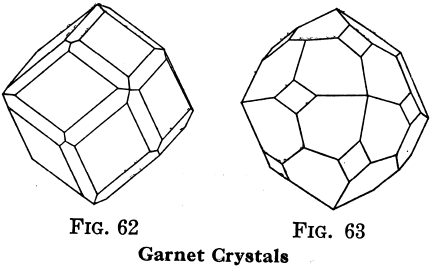
Garnet is found in the contact zone between igneous rocks and crystalline limestone, or in calc sehist, mica schist, granite, gneiss, quartzite. The common varieties are useful as abrasives, particularly in the form of sandpaper. The lime-iron variety has been used as a flux in smelting iron ores. Finely colored, perfectly transparent crystals are valuable as gems. Cinnamon stone is pale red, yellow, and cinnamon-brown. Pyrope, of the characteristic deep red color, is found in peridotite, dunite, and serpentine rock. Almandine, the commoner precious garnet, is found in mica schist, etc. On account of its hardness, garnet survives the weathering and the wearing of the rocks in which it is found, and its weight causes it to collect with other hard, heavy minerals, such as magnetite, zircon, etc.
Olivine, Chrysolite or Peridot
Olivine, Chrysolite or Peridot are silicate of magnesia and iron, varying in composition; color, commonly olive-green, sometimes yellowish green, occasionally reddish; powder, white, rarely yellowish; luster, glassy; H = 6.5 to 7; G = 3.27 to 3.37; usually in grains or crystal masses; cleavage, rather distinct. Has been used in jewelry, but not often found clear and solid enough. Peridot is the name used by jewelers.
Olivine is the principal constituent of the rocks dunite and peridotite; it is also found more or less plentifully in diabase and gabbro. Associated with olivine in these rocks are a number of valuable minerals, including chromite, precious garnet, and platinum. Diamonds have also been found in such rocks. Olivine is also found as a “contact” mineral in dolomite and other magnesian rocks.
Epidote or Pistacite
Epidote or Pistacite is a silicate of lime, alumina, and iron, and water; color, usually yellowish-green or brownish green, sometimes black, yellow, red, gray, white; powder, white or gray; luster, glassy; H = 6 to 7; G = 3.25 to 3-5; cleavage, perfect.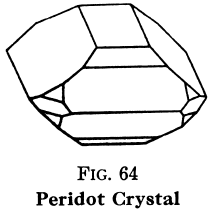
Epidote is found mostly in metamorphic (changed) rocks, such as gneiss, mica schist, hornblende schist, and serpentine, usually as the result of changes caused by neighboring igneous rocks. In the Lake Superior copper district, it is found plentifully, along with quartz and native copper. It has been used as a blast-furnace flux in smelting the Swedish magnetite with which it occurs.
Topaz
Topaz is a silicate of alumina, with fluorine, and sometimes water; color, usually colorless or pale yellow, sometimes pale blue, pink, etc; luster, glassy; H= 8; G= 3.5; crystals, in orthorhombic system; cleavage, perfect. Found in granite, gneiss, talc schist, mica schist.
The finer transparent crystals are used as gems, the pink variety being the most valuable. Topaz accompanies tinstone, both in the ore in place and in placer deposits; it is also found with placer gold; its hardness and weight explain this.
Tourmaline or Schorl
Tourmaline or Schorl minerals are commonly black, brownish black, or bluish black, sometimes blue, green, gray brown, red, pink, rarely white; powder, white or gray; luster, glassy; H = 7 to 7.5; G = 2.98 to 3.2; crystals, in hexagonal system, usually long prisms, sometimes needle-like; the faces are usually finely grooved lengthwise of the prism, and the crystals are more or less triangular in cross section; cleavage, almost absent. When a crystal of tourmaline is heated (or cooled), it becomes positively electrified at one end and negatively at the other end (pyro-electric). 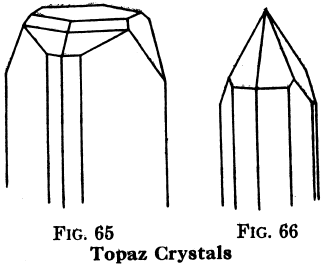 Composition, silicate of alumina and boron, with lime, magnesia, potash, etc., or iron. Iron tourmaline is usually deep black; it resembles black hornblende, but can be distinguished by the grooving and absence of cleavage and the extreme hardness.
Composition, silicate of alumina and boron, with lime, magnesia, potash, etc., or iron. Iron tourmaline is usually deep black; it resembles black hornblende, but can be distinguished by the grooving and absence of cleavage and the extreme hardness.
Tourmaline is usually found in pegmatite granite dikes and other granite masses, and is especially to be found near the contact of such rocks with schist, gneiss, and crystalline limestone. Large masses of tourmaline, commonly called schorl, have been mistaken for coal. Finely colored, transparent crystals are of value as jewels. Rubellite is a pink or red variety containing lithium.
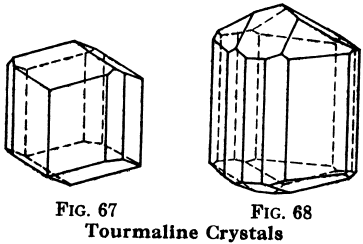
Calamine or Hemimorphite
The Calamine or Hemimorphite; H2Zn2SiO5 has been confused with carbonate of zinc and called Smithsonite; in Great Britain, it is also called electric calamine, a? it is strongly pyro-electric (see Tourmaline, Art, 101). Color, white, sometimes bluish or grayish, rarely yellowish or brownish; powder, White; luster, glassy; H =4.5 to 5; G =3.4 to 3.5; cleavage, perfect. Usually found with zinc blende and galena in limestone and dolomite.
Staurolite
Staurolite is a silicate of aluminum, iron, and hydrogen; color, dark, reddish brown, brownish black, yellowish brown, sometimes gray by weathering; powder, white or gray; luster, between glassy and resinous; H = 7 to 7.5; G= 3.65 to 3.77; crystals, in orthorhombic system, often grown together in the form of a cross (twins); cleavage, good. Found in schists and other metamorphic rocks.
Andalusite
Andalusite is a silicate of aluminum; color, white reddish, violet, brownish, green; powder, white; H = 7.5; G = 3.16 to 3.20; crystals, orthorhombic; cleavage, good. Found in schists and other metamorphic rocks. Sillimanite is a mineral of the same composition as andalusite, which it resembles. It is often of fibrous structure.
Rhodonite
Rhodonite; MnSiO3 is a light brownish red, flesh red, rose pink, sometimes greenish or yellowish, weathers black; powder, white; luster, glassy mineral; H = 5.5 to 6.5; G = 3.4 to 3.68. Found with iron ores and with manganese ores.
Mica
Chlorite
Chlorite is a group of minerals like mica in being cleavable into thin sheets or scales, but lacking the elasticity of mica; when bent, chlorite does not spring back. These minerals are silicates of aluminum, magnesium, and iron, with water; color, usually green; powder, white; luster, earthy or pearly; H = 1 to 3; G = 2.65 to 2,78, Chlorites are mostly secondary minerals, being formed by the alteration of such minerals as biotite, pyroxene, hornblende, etc. There is another use of the word “secondary” as applied to minerals: sometimes a mineral is deposited in fissures, crevices, or hollows in rocks, after the rocks are formed; in such cases, the mineral is said to be secondary, the original minerals of the rock being primary. The quartz of granite is primary; it took its place as the granite was forming. But quartz filling a crack in the granite is secondary; it was brought there later.
Serpentine
Serpentine; H4Mg3Si2O9 is of color green of various shades, brownish red, brownish yellow, yellowish gray, sometimes nearly white; powder, white; luster, waxy or oily; smooth or slightly greasy feel; H = 2.5 to 4, rarely harder; G = 2.50 to 2.65; fracture, shelly or splintery.
This is a secondary mineral, often forming large rock areas by the alteration of such igneous rocks as peridotite, dunite, etc., or of metamorphic rocks composed largely of pyroxene or hornblende. Magnesite, chromite, and platinum are sometimes found in serpentine rock. Verde antique is serpentine mixed with more or less calcite, magnesite, or dolomite, giving it a clouded appearance. Noble serpentine is of a rich green color, and is translucent. Fibrous serpentine is the asbestos mostly in use although fibrous hornblende has also been used as asbestos. Serpentine asbestos is found in veins in ordinary serpentine. The fiber runs across the vein (cross fiber), but there is always a parting in the vein, which cuts across the fiber, the length of which rarely exceeds 2 or 3 inches. Sometimes the fiber runs parallel with the vein (slip fiber), but this slip-fiber asbestos is usually more brittle than the cross-fiber. The value of the asbestos depends on the length and quality of the fiber. First-class fiber can be spun like silk or cotton. The better grades are spun, woven, and used for making firemen’s suits, mitts for furnace workers, etc. The lower grades are used for the manufacture of asbestos sheeting, brake linings, shingles, roofing paper, cement, etc. The quantity of the poorer grades so much exceeds that of the better qualities that the average price for the whole production. The rock as mined averages little worth of asbestos to the ton.
Garnierite
Garnierite is a hydrated silicate of magnesia and nickel, of a bright apple-green color. It is soft, and may be smooth- feeling, like serpentine. G =2.5. Has been mined as an ore of nickel. There are extensive deposits in certain tropical lands awaiting an economical process to treat this ore.
Talc
Talc; H2Mg3Si4O12 is of color white, apple- green, greenish, dark green, or reddish; powder, white or slightly colored; luster, pearly; greasy feel; H = 1 to 1.5; G = 2.7 to 2.8; sometimes foliated, i.e., separable into thin sheets, and occasionally fibrous; mostly a secondary mineral.
Soapstone or steatite
Soapstone or steatite, is a granular talc, more or less impure, and sometimes as hard as 2.5. Potstone and French chalk are other varieties of impure talc. Talc is found in association with serpentine, talc schist, chlorite schist, and especially with dolomite, as in Madoc, Ontario. It sometimes forms extensive rock areas that are quarried for sinks and table tops, where heat and acids are to be resisted, for ornaments, fireplaces, and ovens. Ground, shaped, strongly heated, it is made into gas-burner tips. Ground talc, made from the pure mineral, is used in the manufacture of paper, white cotton goods, talcum powder, lubricants, and paints.
Kaolin or China Clay
Kaolin or China Clay; H4Al2Si2O9 is the composition of the pure mineral, kaolinite. The ordinary varieties of clay are more or less impure. The pure mineral is usually white; it has a greasy feel, powders easily, and when mixed with water it makes a sticky mass; when breathed upon it gives off a peculiar smell, clayey. Although crystallized kaolite has a hardness of 2 to 2.5, the powdery mass usually found is at least as soft as talc. G = 2.6.
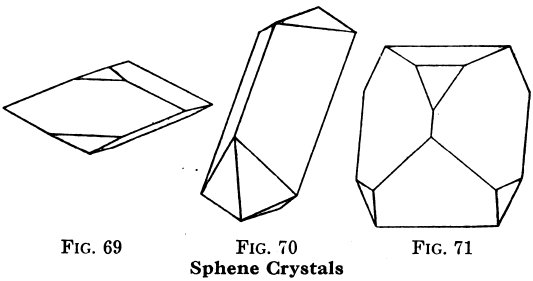
Kaolin is a secondary mineral; it is formed by the alteration of feldspar and other aluminous minerals by the action of water and carbon dioxide, which extract the potash, soda, lime, etc. In this way, masses of granite and similar rocks have in some cases been converted into large clay deposits—sometimes left in place, more or less mixed with quartz, and sometimes washed into hollows, and deposited as clay beds. The best white clay is used in the manufacture of china ware and paper; impure varieties are used in the manufacture of brick, tile, etc. Value, crude kaolin, $4 to $20 per ton. Marl is a mixture of clay and carbonate of lime. It is sometimes used in the manufacture of Portland cement.
Titanite or Sphene
Titanite or Sphene, CaTiSiO5 is in color, usually brown or black, sometimes gray, yellow, green, rose-red; powder, white; luster, diamond-like to resinous; H = 5 to 5.5; G = 3.4 to 3.56; crystals, in monoclinic system, mostly flat and wedge-shaped; cleavage, rather distinct. Found in hornblende granite, syenite, diorite, in nepheline-syenite, and also in schists, gneiss, and crystalline limestones. Since it contains about 40% of titanium oxide, it is of value as an ore of titanium; but it is not often found in quantity.
